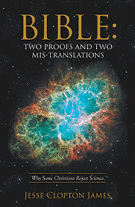Return to 1st Quarter 2018 articles.

Bible: Two Proofs and Two Mis-Translations
by Jesse Clopton James, Westbrow Press, © 2016,
180 pages, $13.95 (paperback) ISBN-13: 978-1-5127-4967-0

If you are looking for a strong rebuttal of young Earth creation theology, this book is for you. James has arrived at the same conclusion as your reviewer but from a different starting point. I have seen young Earth creationists coming to their views from their denominational dispensationalist creeds as I have confronted them in lectureships and public discussions for almost 50 years.
James examines the theological framework of Bible translators as they interpreted Hebrew words according to the traditions of their professors and schools of theology.
We both agree that young Earth arguments do not take the Bible literally. They do not look at who wrote the passages in question, to whom they were written, and how the people of that day would have understood them. Interpreting the Bible by using a western tradition over 1,500 years after the original is not taking the Bible literally.
James argues that the Hebrew word yom in Genesis was translated “day” only because of the bias of the 1611 King James Version translators. He points out passages like Genesis 47:9 where the word yom is better translated “years.” He then traces the way various translators came to their conclusions about that Hebrew word. He does the same for the Hebrew word asah which is translated “make.” As we have pointed out many times, bara (Hebrew for “create”) is used when a miracle of God is involved, but asah is used when there is a natural process. James came to the same conclusion by tracing the theological bias in early English translations of the Bible.
James also argues that God reveals himself in the natural world as well as the written word. He shows that an anti-science viewpoint was the approach of early scholars to the written word leading to bizarre interpretations of many passages. This not only involves the age of the earth but other biblical events as well.
James maintains that when science is compared to Scripture, it shows a solid proof of God's existence. He highlights two proofs. One is that the probability of biblical prophecies being fulfilled by humans is so low as to be discounted. Only the actions of God can account for the fulfillment of the many prophecies. The other proof is the scientific integrity of biblical passages concerning Creation.
James holds a B.A. in physics from Auburn, an M.A. in nuclear physics from Rice, and a Ph.D. from Georgia Tech, so his scientific approach is very strong. The first nine chapters of the book are very useful as they develop this approach with extensive documentation.
Beginning with chapter 10, James presents 20 chapters and two appendices of generally related topics. Some of these chapters are less than a page in length. The topics are covered very briefly and leave many unanswered questions. They include:
- Negative comments on Young earth views.
- Reviews of various conferences on Creation.
- Why people lived so long in the days of Methuselah.
- What killed the dinosaurs.
- Why Barton Stone’s grandson became an atheist.
- The rather sordid history of the Restoration Movement.
Those are just a few examples.
This book is worth the money. It has a great deal of information and some strong arguments about the topics James addresses. However, he tries to cover too much ground. The tone of the book will be offensive to young Earth proponents who are portrayed as being ignorant and negative toward science. In spite of those weaknesses, it contains valid points about the problems of young Earth denominationalism.
We recommend this book for its clear rebuttal of young Earth creation theology.
Scripture links/references are from BibleGateway.com.
